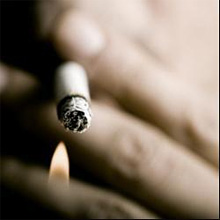
|  |  |  Health & Beauty | July 2008 Health & Beauty | July 2008  
Secondhand Smoke: A Plan to Make it Disappear
 Jody Cross - HealthNews Jody Cross - HealthNews
go to original


| | "Everyone deserves to breathe smoke-free air regardless of where they live or work," according to the President and CEO of the American Lung Association, Bernadette A. Toomey. | | |
The CDC estimates that in 2007 the percentage of people in the United States who still smoked was below 20 percent. France and Ireland, countries with strong smoking cultures, have successfully gone smoke-free; and it is the goal of the American Lung Association that the U.S. be smoke-free by 2010.

People in the U.S. are smoking less, with secondhand smoke definitely on the decline in America. Laws and policies banning smoking in restaurants, office buildings, apartment buildings, and all manner of public places, even the beach in some areas, have been increasing passed and enforced since the early 1990s.

The U.S. Centers for Disease Control and Prevention tested approximately 17,000 nonsmokers, aged 4 and older, comparing the years 1988 through 1994 with the years 1999 through 2004, and the conclusion they reached was that the smoking rate in the U.S. had declined, but was not yet low enough.

The study found that nearly half of the nonsmoking population of the U.S. is still being exposed to secondhand smoke. There was progress: 84 percent of the nonsmokers had tested positive for signs of nicotine in their blood during the late 1980s and early 1990s tests; that number had decreased to 46 percent by the time the tests were repeated in 1999 and 2004.

The CDC found that exposure to secondhand smoke between the years 1999 and 2004 declined from 83 percent to 43 percent among white participants of the study. It decreased from 78 percent to 40 percent among the Mexican-Americans tested, and to 71 percent from 94 percent among black participants in the study. Exposure rates for children did not drop as dramatically as it did for adults. The CDC estimates that some 21 million of America's children are still being exposed to the deadly toxins found in cigarette smoke on a regular basis; that's 35 percent of America's children. The researchers felt that this was because smokers, while smoking less in public places, were probably smoking more in their homes and cars with children present.

They note that secondhand smoke is responsible for more than 100,000 lower respiratory tract infections a year, and the cause of thousands of hospitalizations. Health officials say that children who are exposed to secondhand smoke are also at increased risk for asthma attacks, ear problems, and sudden infant death syndrome. The CDC reminds parents that secondhand smoke is very dangerous for their children to be around, and urges them to take actions to ensure that their children are not exposed.

Despite the efforts of the American Lung Association, the death rate from lung disease is increasing. They estimate that secondhand smoke causes adult nonsmokers 3,400 deaths from lung cancer, and between 22,000, to as many as 69,000 deaths from heart disease each year.

Because secondhand smoke increases nonsmokers risk for getting lung cancer by 20 percent, and heart disease by at least 25 percent, the American Lung Association is actively pressing lawmakers to pass comprehensive legislation to ban smoking in all public places by the year 2010.

They want all states and territories to pass comprehensive smoke-free laws, and to close the loopholes present in existing laws. To date 23 states, the District of Columbia, and Puerto Rico have banned smoking in public areas. |

 |
|  |



